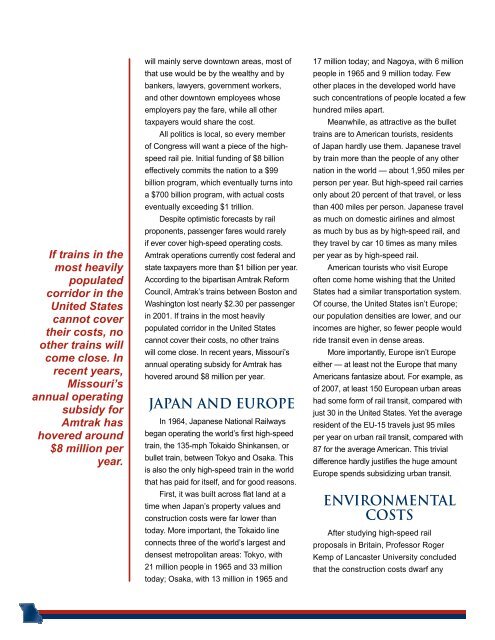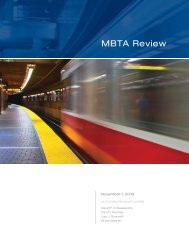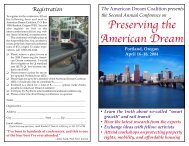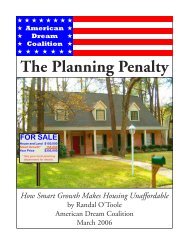Why Missouri Should Not Build High-Speed Rail - American Dream ...
Why Missouri Should Not Build High-Speed Rail - American Dream ...
Why Missouri Should Not Build High-Speed Rail - American Dream ...
You also want an ePaper? Increase the reach of your titles
YUMPU automatically turns print PDFs into web optimized ePapers that Google loves.
If trains in the<br />
most heavily<br />
populated<br />
corridor in the<br />
United States<br />
cannot cover<br />
their costs, no<br />
other trains will<br />
come close. In<br />
recent years,<br />
<strong>Missouri</strong>’s<br />
annual operating<br />
subsidy for<br />
Amtrak has<br />
hovered around<br />
$8 million per<br />
year.<br />
will mainly serve downtown areas, most of<br />
that use would be by the wealthy and by<br />
bankers, lawyers, government workers,<br />
and other downtown employees whose<br />
employers pay the fare, while all other<br />
taxpayers would share the cost.<br />
All politics is local, so every member<br />
of Congress will want a piece of the highspeed<br />
rail pie. Initial funding of $8 billion<br />
effectively commits the nation to a $99<br />
billion program, which eventually turns into<br />
a $700 billion program, with actual costs<br />
eventually exceeding $1 trillion.<br />
Despite optimistic forecasts by rail<br />
proponents, passenger fares would rarely<br />
if ever cover high-speed operating costs.<br />
Amtrak operations currently cost federal and<br />
state taxpayers more than $1 billion per year.<br />
According to the bipartisan Amtrak Reform<br />
Council, Amtrak’s trains between Boston and<br />
Washington lost nearly $2.30 per passenger<br />
in 2001. If trains in the most heavily<br />
populated corridor in the United States<br />
cannot cover their costs, no other trains<br />
will come close. In recent years, <strong>Missouri</strong>’s<br />
annual operating subsidy for Amtrak has<br />
hovered around $8 million per year.<br />
JAPAN AND EUROPE<br />
In 1964, Japanese National <strong>Rail</strong>ways<br />
began operating the world’s first high-speed<br />
train, the 135-mph Tokaido Shinkansen, or<br />
bullet train, between Tokyo and Osaka. This<br />
is also the only high-speed train in the world<br />
that has paid for itself, and for good reasons.<br />
First, it was built across flat land at a<br />
time when Japan’s property values and<br />
construction costs were far lower than<br />
today. More important, the Tokaido line<br />
connects three of the world’s largest and<br />
densest metropolitan areas: Tokyo, with<br />
21 million people in 1965 and 33 million<br />
today; Osaka, with 13 million in 1965 and<br />
17 million today; and Nagoya, with 6 million<br />
people in 1965 and 9 million today. Few<br />
other places in the developed world have<br />
such concentrations of people located a few<br />
hundred miles apart.<br />
Meanwhile, as attractive as the bullet<br />
trains are to <strong>American</strong> tourists, residents<br />
of Japan hardly use them. Japanese travel<br />
by train more than the people of any other<br />
nation in the world — about 1,950 miles per<br />
person per year. But high-speed rail carries<br />
only about 20 percent of that travel, or less<br />
than 400 miles per person. Japanese travel<br />
as much on domestic airlines and almost<br />
as much by bus as by high-speed rail, and<br />
they travel by car 10 times as many miles<br />
per year as by high-speed rail.<br />
<strong>American</strong> tourists who visit Europe<br />
often come home wishing that the United<br />
States had a similar transportation system.<br />
Of course, the United States isn’t Europe;<br />
our population densities are lower, and our<br />
incomes are higher, so fewer people would<br />
ride transit even in dense areas.<br />
More importantly, Europe isn’t Europe<br />
either — at least not the Europe that many<br />
<strong>American</strong>s fantasize about. For example, as<br />
of 2007, at least 150 European urban areas<br />
had some form of rail transit, compared with<br />
just 30 in the United States. Yet the average<br />
resident of the EU-15 travels just 95 miles<br />
per year on urban rail transit, compared with<br />
87 for the average <strong>American</strong>. This trivial<br />
difference hardly justifies the huge amount<br />
Europe spends subsidizing urban transit.<br />
ENVIRONMENTAL<br />
COSTS<br />
After studying high-speed rail<br />
proposals in Britain, Professor Roger<br />
Kemp of Lancaster University concluded<br />
that the construction costs dwarf any






